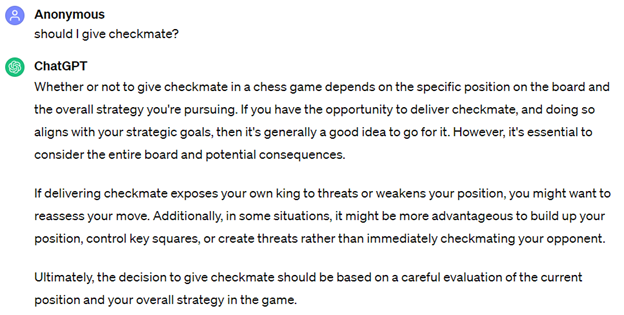On May 11, 1997, IBM’s Big Blue defeated a chess player that many consider the best or second-best chess player of all time, Garry Kasparov, and with that victory, ushered in a new era in AI. Within a few years, simple and cheap programs could beat every human chess player on the planet without breaking an electronic sweat.
Despite many predictions that this new era heralded the end of serious chess competition, the opposite has happened – human chess has blossomed both at the amateur level (my level) and grandmaster, world champion level.
How the chess world handled super-intelligent AI has some lessons for both current and future uses and impacts of Gen AI / LLM:
Four lessons:
- It is really important to develop robust cheating detection processes.
- The combination of human and AI beats either by itself
- One of the most productive uses of AI is as a teacher.
- To be a real super-mind, Gen AI/LLM needs new models and complex reasoning skills
Robust cheating detection There are currently software vendors like WinstonAI that claim to be able to detect AI generated text with 99%+ accuracy. But the more complex issues are detecting the combination of AI and human text and developing standards for when that is OK or not. In the business world, using a Gen AI as a first draft isn’t cheating, it’s being smart. If and when Gen AI gets smarter and a better writer than humans in more and more fields, the situation will be more complex.
In school and in-person competition environments, chess has pretty well figured it out – don’t allow access to anything that can “talk” to a computer or phone. In school environments, while in-person work can be monitored, what about homework? The situation where the use of Gen AI is seen as cheating will likely be replaced by redesigning schoolwork to focus more on editing skills and how best to work with AI, coupled with AI detection software.
Cyborg Chess beats Big Blue.
While quite a few people know about Big Blue beating Garry Kasparov, not many know that one of Kasparov’s responses was to form an approach that combined computer chess with human grandmasters – and they consistently won against the best computer chess. The computer provided a depth of calculation beyond any human and the human grandmaster provided a theoretical depth that computers could not match.
And that provides a great example of the best way to get the most out of AI: the combination of AI and human beats AI or human alone.
Gen AI as teacher Chess has been using AI for years with the primary goal of teaching humans how to play chess better. AI programs do this by evaluating each move and how it impacts its overall score for each position. This calculated score is typically supplemented by traditional teaching methods that provide the theoretical principles that humans are best at.
Gen AI Doesn’t Understand Chess
This lack of understanding can be seen in all its hilarious manifestations in a recent attempt to get ChatGPT to offer advice on chess moves. Not only did ChatGPT miss Fools Mate, when asked about checkmate in general replied:

This is, of course, nonsense. As any chess player knows, checkmate wins the game – period. End of game. You win.
Conclusion
The intersection of specialized, complex knowledge and the most popular language about that specialized knowledge is one of the key themes that will determine the future of AI. IOW, Gen AI/LLMs do not a super-mind make. You need other, deeper knowledge representations and reasoning capabilities.
But that is a topic for future blog posts.